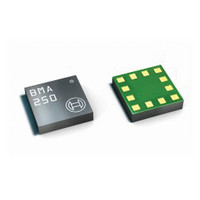BMA250 Bosch Sensortec, BMA250 Datasheet - Page 57

BMA250
Manufacturer Part Number
BMA250
Description
3-AXIS ACCELEROMETER DIGITAL I/F
Manufacturer
Bosch Sensortec
Series
-r
Specifications of BMA250
Featured Product
BMA250 - Digital, Triaxial Acceleration Sensor
Axis
X, Y, Z
Acceleration Range
±2g, 4g, 8g, 16g
Sensitivity
256LSB/g, 128LSB/g, 64LSB/g, 16LSB/g
Voltage - Supply
1.62 V ~ 3.6 V
Output Type
I²C™, SPI™
Bandwidth
8Hz ~ 1kHz
Interface
I²C, SPI
Mounting Type
Surface Mount
Package / Case
12-VQFN
Lead Free Status / Rohs Status
Lead free / RoHS Compliant
For Use With
828-1024 - BMA250 DAUGHTERCARD FOR DEV KIT
Other names
828-1023-2
Available stocks
Company
Part Number
Manufacturer
Quantity
Price
Part Number:
BMA250
Manufacturer:
BOSCH/博世
Quantity:
20 000
Company:
Part Number:
BMA250E
Manufacturer:
AME
Quantity:
12 000
Part Number:
BMA250E
Manufacturer:
BOSCH/博世
Quantity:
20 000
Part Number:
BMA250E(F)
Manufacturer:
BOSCH/博世
Quantity:
20 000
Part Number:
BMA250E-F
Manufacturer:
BOSCH/博世
Quantity:
20 000
Company:
Part Number:
BMA250EF
Manufacturer:
TE
Quantity:
30 000
Part Number:
BMA250EF
Manufacturer:
BOSCH/博世
Quantity:
20 000
The data bits are used as follows:
Bit0: Read/Write bit. When 0, the data SDI is written into the chip. When 1, the data SDO from
the chip is read.
Bit1-7: Address AD(6:0).
Bit8-15: when in write mode, these are the data SDI, which will be written into the address.
When in read mode, these are the data SDO, which are read from the address.
Multiple read operations are possible by keeping CSB low and continuing the data transfer. Only
the first register address has to be written. Addresses are automatically incremented after each
read access as long as CSB stays active low.
The principle of multiple read is shown in figure 13:
In SPI 3-wire configuration CSB (chip select low active), SCK (serial clock), and SDI (serial
data input and output) pins are used. The communication starts when the CSB is pulled low by
the SPI master and stops when CSB is pulled high. SCK is also controlled by SPI master. SDI is
driven (when used as input of the device) at the falling edge of SCK and should be captured
(when used as the output of the device) at the rising edge of SCK.
The protocol as such is the same in 3-wire configuration as it is in 4-wire configuration. The
basic operation waveform (read or write access) for 3-wire configuration is depicted in figure 14:
Rev. 1.0
© Bosch Sensortec GmbH reserves all rights even in the event of industrial property rights. We reserve all rights of disposal such
as copying and passing on to third parties. BOSCH and the symbol are registered trademarks of Robert Bosch GmbH, Germany.
Note: Specifications within this document are subject to change without notice.
CSB
Start
=
0
RW
1
CSB
SCK
SDI
0
0
Register adress (02h)
Control byte
0
0
Figure 14: 3-wire basic SPI read or write sequence (mode ´11´)
RW
0
AD6
1
0
AD5
X
AD4
X
Data register - adress 02h
X
Page 57 / not for publishing
AD3
Figure 13: SPI multiple read
Data byte
X
AD2
X
X
Data sheet
BMA250
AD1
X
AD0
X
X
DI7
X
Data register - adress 03h
DI6
X
Data byte
X
DI5
X
DI4
X
X
DI3
X
DI2
X
DI1
X
Data register - adress 04h
Bosch Sensortec
X
DI0
03 March 2011
Data byte
X
X
X
X
X
Stop
CSB
=
1


























